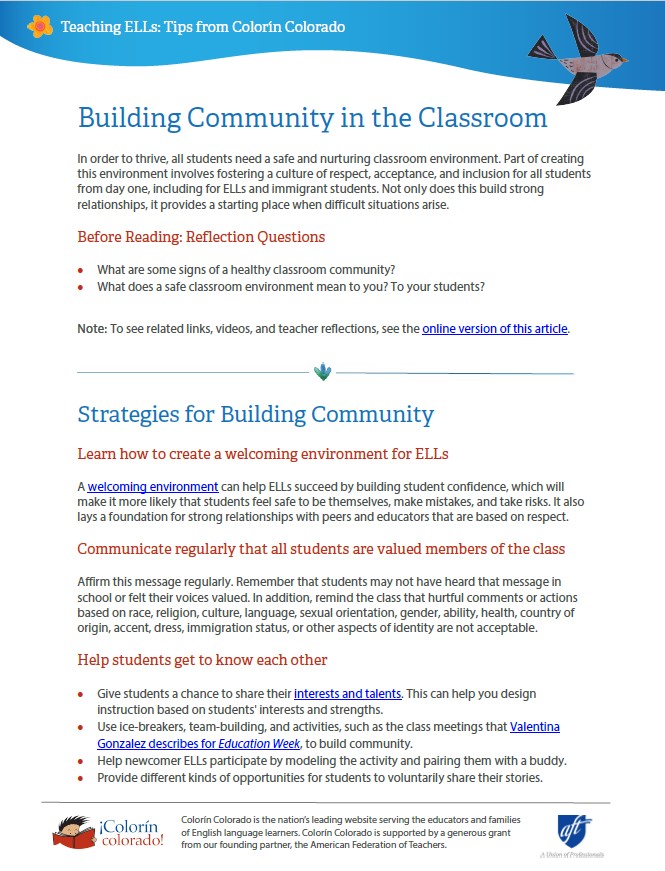Developing Students’ Discussion Skills

Learn how to give students the tools and language they need to participate in classroom discussions, express opinions, and navigate disagreement. This article is part of Navigating Tough Topics in the Classroom: Tips for ELL Educators.
Photo credit: Photo by Allison Shelley
Acknowledgements
 This project was made possible with support from the American Federation of Teachers.
This project was made possible with support from the American Federation of Teachers.
Classroom discussions are an important part of learning across different content areas. Learning how to participate in these discussions gives students important skills that they can use in their personal, academic, and professional lives.
For English language learners (ELLs), it's particularly important to give students the language, tools, and confidence they need to develop these skills in another language. Ideas on how to do so are included below.
 Before Reading: Reflection Questions
Before Reading: Reflection Questions
- Think of successful classroom discussions you have seen. What worked well?
- Think of challenging classroom discussions you have seen. What didn't work?
Developing Shared Expectations and Guidelines
Creating a shared list of expectations for classroom discussions provides a protocol when students want or need to discuss difficult topics in the classroom. Here are some tips for developing those guidelines together.
Brainstorm guidelines for class discussion together
As part of your process for creating classroom guidelines, create a list of guidelines for discussion. These guidelines may also be useful for online discussion platforms as well.
- Start by asking students why it is important to have guidelines in place for discussion.
- Talk with students about body language and share some examples of how appropriate body language may vary in different cultures.
- Explain norms of body language during conversation in the U.S., such as keeping a polite distance or making eye contact.
- Brainstorm examples of "do’s and don’ts" for a good discussion, such as the following:
| In our class, we.... | In our class, we don't.... |
|
|
After the brainstorm
- Streamline students’ brainstorm into a manageable list of guidelines that you can refer to easily during any class discussion.
- Add guidelines that might be missing. Have students create an infographic.
- Translate this list into ELLs’ languages if possible.
- Act it out so the behavior is clearly understood by everyone.
- Remind students of these norms each time you start a new discussion activity, particularly if students are struggling with discussions.
See more ideas from Martha Caldwell and Oman Frame in their response on teaching about controversial topics. You may also wish to consider using "QSSSA" or the SLANT strategy as a structured method to scaffold conversations. In addition, Jeff Zwiers has great tools that fosters rich communication and productive academic conversations across disciplines and grade levels.
Resources
- Discussion protocol shared by Meg Riordan and by Gabriella Corales
- Building Community with Student-Driven Discussions (Edutopia)
- Collaborative Culture: Protocols (EL Education)
- Participation Protocol for Academic Discussions (Teaching Channel)
Be mindful of cultural differences that might impact discussions
Ask cultural liaisons or ESL teachers if there are any cultural considerations you should keep in mind during class discussions that include ELLs and immigrant students, especially around activities such as listening, debating, and asking questions. Also consider being mindful of cultural differences in gender interactions (for example, how boys interact with girls or vice versa).
Remind students that there is no such thing as a stupid question
If a question indicates that someone has a different experience from their classmates, remind students to respect the questioner and think about how to respectfully answer the question. You may wish to ask a clarifying question first.
If a question’s intent or delivery is disrespectful:
- remind students of the examples of respectful and disrespectful behavior
- offer responses that students can use to express their feelings about the question or what it implies
- talk about whether there is a learning opportunity in the question
See more on this topic from Lorena German’s response on discussing controversial topics.
Identify some important parameters for yourself
- Model being open-minded.
- Answer only the questions that have been asked.
- Stay focused on the topic at hand.
- Set time limits for discussion.
- Be honest when you don’t know the answer.
- Get support if you need it.
- Have some ways to start and conclude discussions.
- Providing students with language and practice
Gives students the language they need to express themselves
Give students sentence frames and sentence starters that illustrate how to express different kinds of responses, such as agreement, disagreement, or supporting a point with facts. Provide these on a sheet that students can keep handy and post them on the wall or online for virtual learning.
For ELLs, consider printing the sheet in English and their native language. This might include phrases such as:
- "I have a different point of view..."
- "Have you ever thought about ...?"
- "I care about you, but I disagree because..."
- "What if..."
- "What do you think..."
- "When you say ____, I feel..."
- "I would like..."
- "Have you considered....?"
- "At first I thought...but then I learned..."
Practice using these phrases in 'low stakes' conversations so that students get used to them before using them for bigger topics. You can learn more from teacher Meg Riordan.
Resources
- Academic Conversations with ELLs: Series (Teaching Channel)
- Talk Moves in Academic Discussions (Teaching Channel)
- Improving Participation with Talk Moves (Teaching Channel)
- Teaching Talk Moves (Teaching Channel)
- Save the Last Word for Me (Facing History)
Introduce different kinds of discussion activities in your lesson plans
Use a variety of activities that will give your students different kinds of skills in discussion. In addition to the format of the activity, consider specific skills that will be useful and make discussion more meaningful, such as connecting a comment to the previous comment or disagreeing in a respectful manner. The more carefully you plan these activities, the more successful they will be! You may also wish to focus your activities on skills outlined in your state’s college- and career-ready standards.
Activity ideas
- Increase Student Interaction with "Think-Pair-Shares" and "Circle Chats"
- Pop-up Debate (Dave Stuart Jr.)
- Structured Academic Controversy (Teaching History)
- Civil Discourse in the Classroom (Teaching Tolerance)
Facing History
- Think, Pair, Share
- Fishbowl discussion
- Four Corners
- Town Hall Circle
- Learn to Listen, Listen to Learn
- Wraparound (Whiparound)
- SPAR
Socratic Seminar Resources
- Strategies for ELLs (Colorín Colorado)
- Socratic Seminar Overview (Facing History)
Create a good questioning protocol for clarifying, getting more information, and including others
Use a questioning protocol that increases engagement of all students will generate more student "cross-talk" during the discussion. For example, cross questioning involves asking other students for their opinion after a student shares their thinking. "Gina, do you agree with what Marco said?" "Do you have something to add?" Start questions with "How" or "In what ways..."
- Assign students roles for monitoring the discussion process.
- Report out at the end.
- How did the class do inviting others into the discussion? Sharing new ideas with evidence or experience as examples?
Give students a task while they are listening to discussions
In order to keep students engaged while other students are speaking (as well as to prevent confusion and misunderstanding), set an expectation that all students are listening and then collect evidence of their listening, such as using:
- popsicle sticks in a can and pulling them out randomly to ask direct questions
- a note-taking page so students can use
- a sentence starter to ask a question of their peer
Look for ways to engage quieter students
- Consider using an activity such as "two cents" or talking chips in which students are prompted to contribute to the conversation.
- Encourage more expressive students to elicit responses from quieter classmates by challenging them to say, "What do you think, _?" or "What's your opinion, _?"
- Have students talk to an "elbow partner" before asking them to share in a large group.
- Talk with students one-on-one and give them a chance to answer questions in personal conversations with you or partners to build confidence.
- Offer regular opportunities for writing so that students who don’t participate in the group discussions still have an opportunity to express their opinions.
Keep in mind that newcomer ELLs may go through a ‘silent period’
It is very common for students who are learning a new language to be ‘silent’ for a period of time, when they are listening to the language around them without speaking yet. This is considered the first stage of language acquisition.
- Be patient.
- Give the ELLs opportunities for small successes in speaking with you and individual peers before speaking in front of larger groups.
- Give ELLs lots of practice with the content and language that they will need to present in front of others.
Resources
Think about how the classroom is laid out throughout the day and during discussion
- For in-person learning, consider whether grouping desks might lead to more collaboration and conversation, or whether you want to move chairs into a circle when it’s time for a group discussion, as well as where you wish to be during those discussions.
- If it's possible, set up a cozy corner where students could go have a "discussion" hangout. This is very valuable when students may be talking about something challenging such as an emotional experience - and may be worth creating in virtual classrooms too!
Look for ways to incorporate peer learning and collaboration early and often
Try different ways to use peer learning with ELLs, especially activities that center around discussion and collaboration. Don’t be afraid of trial and error! With practice, you and your students will figure out what kinds of peer activities work best for the group.
Tools for navigating disagreement and conflict
Discuss the value of debate, different opinions, and disagreement
Ask students to talk about the benefits of:
- thinking before you speak
- focusing discussion on ideas, not on people
- keeping an open mind
- trying to understand other points of view. (You may learn something new, you may make a more informed decision, etc.)
Ask students about the impacts when people can’t find common ground or listen to each other.
Give students tools for conflict resolution and expressing disagreement
Start by reminding students that:
- your classroom community maintains respect for all voices and perspectives, including minority views, different, conflicting, or opposing views
- when you disagree, you disagree with the idea and not the person
- while students are entitled to express their opinions, they are expected to do so in a way that demonstrates respect to their classmates
- when something said to a student upsets them, they can say "ouch", which conveys their hurt feelings to the speaker even if they don’t yet have the vocabulary to accurately express it in words.
Talk with students about their options for handling different opinions, as well as the language needed to express those different opinions. For more perspectives on navigating disagreement, see Dave Stuart, Jr.’s response on teaching about controversial topics and Danny Woo’s activity "Agree or disagree."
Share real-life examples of debate and discussion
As students become more familiar with discussion formats, give them chances to critique other examples through video or audio. If your school has a debate team, you may wish to see if your students can attend some debates or join the team.

